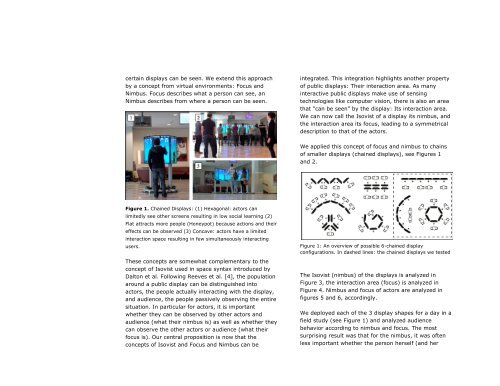Nimbus & Focus: The Impact of Architectural Design ... - Gilles Bailly
Nimbus & Focus: The Impact of Architectural Design ... - Gilles Bailly
Nimbus & Focus: The Impact of Architectural Design ... - Gilles Bailly
You also want an ePaper? Increase the reach of your titles
YUMPU automatically turns print PDFs into web optimized ePapers that Google loves.
certain displays can be seen. We extend this approach<br />
by a concept from virtual environments: <strong>Focus</strong> and<br />
<strong>Nimbus</strong>. <strong>Focus</strong> describes what a person can see, an<br />
<strong>Nimbus</strong> describes from where a person can be seen.<br />
integrated. This integration highlights another property<br />
<strong>of</strong> public displays: <strong>The</strong>ir interaction area. As many<br />
interactive public displays make use <strong>of</strong> sensing<br />
technologies like computer vision, there is also an area<br />
that “can be seen” by the display: Its interaction area.<br />
We can now call the Isovist <strong>of</strong> a display its nimbus, and<br />
the interaction area its focus, leading to a symmetrical<br />
description to that <strong>of</strong> the actors.<br />
We applied this concept <strong>of</strong> focus and nimbus to chains<br />
<strong>of</strong> smaller displays (chained displays), see Figures 1<br />
and 2.<br />
Figure 1. Chained Displays: (1) Hexagonal: actors can<br />
limitedly see other screens resulting in low social learning (2)<br />
Flat attracts more people (Honeypot) because actions and their<br />
effects can be observed (3) Concave: actors have a limited<br />
interaction space resulting in few simultaneously interacting<br />
users.<br />
<strong>The</strong>se concepts are somewhat complementary to the<br />
concept <strong>of</strong> Isovist used in space syntax introduced by<br />
Dalton et al. Following Reeves et al. [4], the population<br />
around a public display can be distinguished into<br />
actors, the people actually interacting with the display,<br />
and audience, the people passively observing the entire<br />
situation. In particular for actors, it is important<br />
whether they can be observed by other actors and<br />
audience (what their nimbus is) as well as whether they<br />
can observe the other actors or audience (what their<br />
focus is). Our central proposition is now that the<br />
concepts <strong>of</strong> Isovist and <strong>Focus</strong> and <strong>Nimbus</strong> can be<br />
Figure 1: An overview <strong>of</strong> possible 6-chained display<br />
configurations. In dashed lines: the chained displays we tested<br />
<strong>The</strong> Isovist (nimbus) <strong>of</strong> the displays is analyzed in<br />
Figure 3, the interaction area (focus) is analyzed in<br />
Figure 4. <strong>Nimbus</strong> and focus <strong>of</strong> actors are analyzed in<br />
figures 5 and 6, accordingly.<br />
We deployed each <strong>of</strong> the 3 display shapes for a day in a<br />
field study (see Figure 1) and analyzed audience<br />
behavior according to nimbus and focus. <strong>The</strong> most<br />
surprising result was that for the nimbus, it was <strong>of</strong>ten<br />
less important whether the person herself (and her



